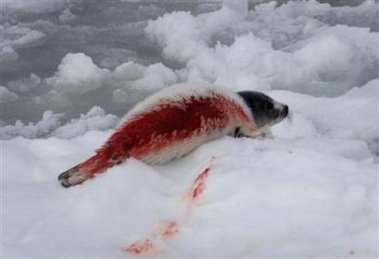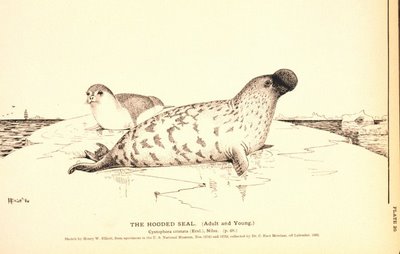
Data File 3 - The Canadian Seal Hunt.
(photo courtesy of AP Photo/IFAW, Stewart Cook, HO)
A 'raggedy-jacket' harp seal pup shot by a seal hunter.
Harp seal pups start with white fur and molt over a period of a few weeks. This pup is so young, it is only just beginning to molt. It is illegal to hunt 'whitecoat' pups but the Canadian Department of Fisheries and Oceans allows pups just starting to molt to be killed (12 to 14 days after they are born).
The Canadian Seal Hunt is a thinly disguised effort by the Canadian government to excuse subsidising the politically powerful Canadian fishing community. It also negatively impacts on the economic benefits which should be available to sustainable First Nation hunting.
The pro Seal Hunt lobby have picked up on the new trend by commercial operations and their supporters of attempting to 'greenwash' unsustainable harvesting of natural resources. This is achieved in part by using the disingenuous propaganda that the commercial industry are performing a vital 'environmental' service to protect one or more 'really' endangered species, supposedly 'threatened' by the species they are exploiting.
Needless to say this kind of propaganda is a complete fabrication and has no scientific basis. It also usually disguises the fact that the commercial industry in question is the real culprit for the 'really' endangered status (by unsustainable over harvesting) of the species they now claim to be trying to 'protect'.
This 'greenwashing' theme will recur in other Data Files, notably my Whaling Data File (when I have completed it).
The Seal Hunt lobby have disingenuously tried to 'greenwash' their operation twice over.
First, by blaming harp seals for the lack of cod in Canadian waters; however it was the Canadian commercial cod fishery not seals that caused the decimation of cod populations in Canadian waters. Even the Canadian Department of Fisheries and Oceans has officially stated that the Seal Hunt is not a cull to protect cod stocks.
What do harp seals eat?
In the St. Lawrence River they eat capelin from December to February, prior to the pupping season. Lactating females and moulting harp seals feed infrequently, although mothers forage intensively on capelin in the St. Lawrence River after weaning their pups.
Atlantic cod, including the northern cod stock, is a minor component of the annual harp seal diet.
- Wallace, S.D and J.W. Lawson. 1997. A review of stomach contents of harp seals (Phoca groenlandica) from the Northwest Atlantic: an update. IMMA Technincal Report 97-01. 99pp.
The pro Seal Hunt lobby's second 'greenwashing' allegation is that harp seals are outcompeting walruses for food. This propaganda is as false as the claim about cod.

(photo courtesy of Geek Philosopher)
What do walruses eat?
Walruses prefer molluscs, mainly bivalves such as clams. They suck bivalve animals from the shells. Walruses also eat many other kinds of benthic invertebrates including worms, gastropods, cephalopods, crustaceans, sea cucumbers, and other soft-bodied animals. Walruses may occasionally prey on fishes such as polar cod.
Walruses may eat the remains of young seals when food is scarce.
There are some rare but habitual seal-eating walruses. Their diet consists mainly of ringed and bearded seals. These are usually male walruses, recognizable because they are usually larger than other males with powerful shoulder and chest muscles. Their skin may become grease-stained from the blubber of the seals.
So the allegation that harp seals compete with walruses is clearly untrue.
To return to the cod allegation, here are the comments of Doug Sweetland a Canadian Inshore cod fisherman, who is still a politically active lobbyist for the Canadian Inshore cod fishing industry.
'Doug Sweetland is even-handed in dishing out blame. "Everyone contributed to the decline of the cod. The main culprits were the draggers because of high grading".
High Grading is where fishermen keep catching fish and throwing away the ones they don't want until they have achieved a hold of premium-size fish.
"The plant in Catalina employed 1,500 people. They were getting so much fish in the mid-1980s that they said 26 inches (65cms) is the smallest fish we want. You know where the rest was going - over the side dead. That destroyed a million pounds of fish to get 400,000lb (180.000kg)."
Doug remembers how quickly the end came.
"In the winter of '92 there was good cod. Within three months there was nothing. The offshore fishery had shot itself down."
- Doug Sweetland, Newfoundland cod fisherman refering to the Canadian Cod Fishery between the mid 1980s and 1992, from The End of the Line by Charles Clover.
Readers will notice that Doug Sweetland doesn't mention harp seals at all.
The false allegation that seals are a threat to fishermen continues to hound them, even when the seal species in question is a seriously endangered one.
‘Furthermore, I am reminded from my work on endangered Mediterranean monk seals that as long as seals and fisheries overlap, someone will want to remove seals from the system. Today, only some 500 Mediterranean monk seals exist in the Mediterranean and in the Northeast Atlantic off the coast of Northwest Africa. They are one of the most endangered of all seal species. Yet fishers in the Mediterranean still kill them because they perceive them to be competing with them for their livelihood.’
- David Lavigne, PhD
http://www.imma.org/fishcomm/#cull
Common sense points out that for thousands of years before industrialised commercial fishing methods were introduced (in the 1950s) there was clearly no threat to what where vast cod stocks from their natural predators; who actually demonstrate what genuine ‘sustainable harvesting’ means.

(illustration courtesy of NOAA)
Why is the Canadian Seal Hunt so important to the Canadian fishing industry?
Very simple, for political reasons the Canadian government only requires people in the fishing industry (which includes Seal hunters) to work for 14 weeks of the year to qualify for employment insurance benefits, other Canadians have to subsidise them for the rest of the year. Individual seal hunters only earn approximately $1000 from the Seal Hunt itself.
Larry Tremblett - Ex Inshore cod fisherman,
'He makes enough in the 14 week spring season for crab to qualify for employment insurance...which the government pays for the rest of the year.'
Doug Sweetland - Ex Inshore cod fisherman,
'catches crab. lobster, and lumpfish to qualify for his EI.'
Ransom Myers - Ex Canadian Department of Fisheries and Oceans,
'With employment insurance it is not inconceivable that a couple can make C$60,000 (£25,000) a year, spending 14 weeks catching or processing crab or other fish.....for fishermen all business expenditure is allowable against tax........' Myers says you won't hear a peep of criticism of this state benefit system coming from the DFO's big, modern building in St. John's. 'For an academic in Newfoundland to say anything against employment insurance is totally unthinkable. It's not even discussed'.
- first person interviews from The End of the Line by Charles Clover.
St. John's, Newfoundland - 'Former employees in Harbor Breton haven't worked for more than two years, except for projects to extend their employment insurance claims.'
- Tara Brautigam, The ChronicleHerald, Halifax, Nova Scotia, 22nd May 2006
"It's sad to say when you [have] to talk about EI with a million-dollar boat, but you know, that's what's in the fleet, people with million-dollar enterprises just looking to break even,"
- Dwight Spence, fishes from Port au Choix for shrimp and snow crab
CBC News. 24th April 2006
Canadian Employment Insurance (EI) Fishing Benefits -
http://www.sdc.gc.ca/asp/gateway.asp?hr=en/ei/types/fishing.shtml&hs=
'EI is especially important in the Atlantic provinces, which have higher rates of unemployment. Many Atlantic workers are also employed in seasonal work such as fishing and go on EI over the winter when there is no work. There are special rules for fishers making it easier for them to collect EI.'
- Wikipedia
'The purpose of the proposed regulation amendment is to put in place a pilot project designed to test the labour market impacts of DECREASING (my capitals), for new entrants and re-entrants to the labour force who have access to employment programs established under Part II of the Act, the number of hours of insurable employment required in order for them to qualify for benefits.'
http://canadagazette.gc.ca/partI/2005/20051008/html/regle4-e.html
'The Government of Canada will increase the duration of parental benefits'
http://canadagazette.gc.ca/partII/2000/20001108/html/sor394-e.html

(hooded seal illustration courtesy of NOAA)
To give readers an idea of the large number of voters in receipt of these benefits and therefore the massive sums involved -
'fishing benefits paid $217.0 million' - 2000
http://www.rhdcc.gc.ca/asp/gateway.asp?hr=/en/ei/reports/eimar_2000.shtml&hs=aed
'fishing benefits increased 8.6% to $235.6 million' - 2001
http://www.rhdcc.gc.ca/asp/gateway.asp?hr=/en/ei/reports/eimar_2001.shtml&hs=aed
'fishing benefits increased by 4.8% to $246.9 million' - 2002
http://www.rhdcc.gc.ca/asp/gateway.asp?hr=/en/ei/reports/eimar_2002.shtml&hs=aed
Interestingly in 2003, 2004, 2005, someone in the Canadian government appears to have decided that providing the fishing benefits figures so straightforwardly in the Executive Summary was politically imprudent and so it stopped doing so; however the figures are still there, just better hidden.
Fishing benefits paid $274.3 million - 2002 to 2003
Fishing benefits paid $298.1 million - 2003 to 2004
Fishing benefits paid $293.2 million - 2004 to 2005
- Canadian Department of Human Resources and Social Development,
2005 Monitoring and Assessment Report, Annex 2
The Pro Seal Hunt propaganda suggests that the hunt is only designed to keep Harp Seal numbers at their existing levels, this is also untrue.
"When such hunting pressure last occurred, the harp seal population declined rapidly by over 50 percent," said Harris. "Given seals only reach breeding age at about five to six years old, it could be too late to intervene by the time the impacts of current hunting levels are understood."
- Professor Stephen Harris of Bristol University
'Harp seal populations in the northwestern Atlantic: modelling populations with uncertainty'
'Harris notes that the current DFO population estimate for harp seals relied on a very small sample size. Less than two percent of the breeding site was evaluated to extrapolate the population.
Harris points out that several other Canadian fisheries, such as the cod fishery, have collapsed over the years as a consequence of many variables, including environmental change and mismanagement. The harp seal management plan does not apply a precautionary principle, Harris says, and so threatens the survival of seal populations.
The 2006 hunt quota of 325,000 harp seals, as well as 10,000 hooded seals and 10,400 grey seals (the TAC over the last 4 years are the highest kill levels since the 1950s) depresses the value of the additional 10,000 allocation to aboriginal hunters but that does not appear to be a genuine concern for anyone benefiting from the welfare subsidies available through taking part in the larger hunt.
While Greenland has a seal hunt, the Greenland government ordered its publicly owned tannery, Great Greenland, to stop buying Canadian seal pelts as of January 1, 2006 because of its opposition to the Newfoundland seal hunt.
- Environmental News Service 28 May 2006.

(Grey seal photo courtesy of Erik Christensen)
The Pro-Seal Hunt propaganda likes to points out that these seals are not 'endangered'.
Sustainability is about making sure that animals do not become endangered, not waiting until they are!
The Canadian fishing industry (like many other nations' fishing industries) has had ample opportunity to join forces with environmental NGOs to highlight the unsustainable nature of modern industrialised fishing practies and to lobby for improved fishing practises and draconian legislation efficiently enforced, to protect their fish stocks.
That the Canadian fishing industry prefers to create another unsustainable industry to assist them in qualifying for welfare benefits, informs readers exactly how little some of these communities value their traditions and culture.
http://www.fish4ever.org/sustainablefish.php


0 Comments:
Post a Comment
<< Home